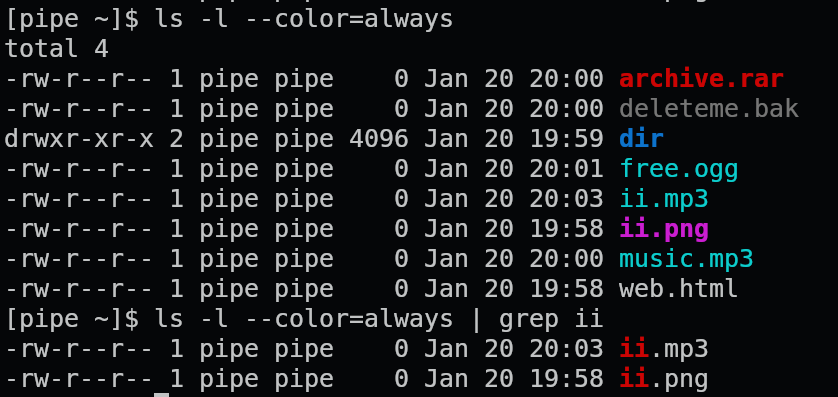retain terminal output colors through piped commands?
from linuxPIPEpower@discuss.tchncs.de to linux@lemmy.ml on 20 Jan 2025 20:23
https://discuss.tchncs.de/post/28936595
from linuxPIPEpower@discuss.tchncs.de to linux@lemmy.ml on 20 Jan 2025 20:23
https://discuss.tchncs.de/post/28936595
Is there anyway to pass terminal colors through a pipe?
As a simple example, ls -l --color=always | grep ii.
When you just run the ls -l --color=always part alone, you get the filenames color coded. But adding grep ii removes the color coding and just has the grep match highlighting.
Screenshot of both examples:

In the above example I would want ii.mp3 and ii.png filenames to retain the cyan and magenta highlighting, respectively. With or without the grep match highlighting.
Question is not specific to ls or grep.
If this is possible, is there a correct term/name for it? I am unable to locate anything.
threaded - newest
hmm this gives me all colors (from ls and grep)
(I’m using their full paths because I usually alias
lsandgreptoezaandrgrespectively)There’s a
export CLICOLOR_FORCE=1you can try to avoid repeating–color=always, but that didn’t work for me withlsandgrepspecifically.Edit: there’s also a
FORCE_COLOR=1that is popular, but again, neitherlsnorgrepseem to care.hot tip, you can avoid the ls alias by running \ls
Color codes will pass through pipes just like any other output.
In this case, your grep is being smarter than you want and actually parsing the incoming color codes itself.
You can try a simpler program like
head,tail, or evensed -n /ii/pto see it for yourself.You can also control GNU grep’s color processing with
–colorbut you may not find exactly what you seek.For the most part, this happens because those programs check if stdout is a pseudo-terminal (pty) and automatically disable color output because if you’re doing say
ls -land try to parse it, you’ll have all the ANSI escape sequences mixed in, so for safety and predictability they disable color.It is unfortunately a per-program thing. It is possible to fake it using
scriptorunbufferaccording to stackoverflow.com/a/32981392Looks like
socatcan also be used for that: unix.stackexchange.com/a/157463TL;DR - Essentially you’re attempting to mix two types of output, a pipe with a terminal. This is pretty much not going to work as expected.
To make colour in a terminal, commands like
lsadd so-called Escape sequences, a series of bytes that your terminal knows how to interpret as colour.Whilst you might be able to force those characters though a pipe, they’re just characters, so if you only grab part of those characters, you’ll create invalid Escape sequences and all hell will break loose, exactly like what happens if you run
caton a binary file and the terminal display goes haywire. You can often recover using theresetcommand.This is why programs like
lsandgrepdetect if they’re running as a terminal command or a pipe command and suppress the Escape sequences when you are sending their output to anything other than a terminal.